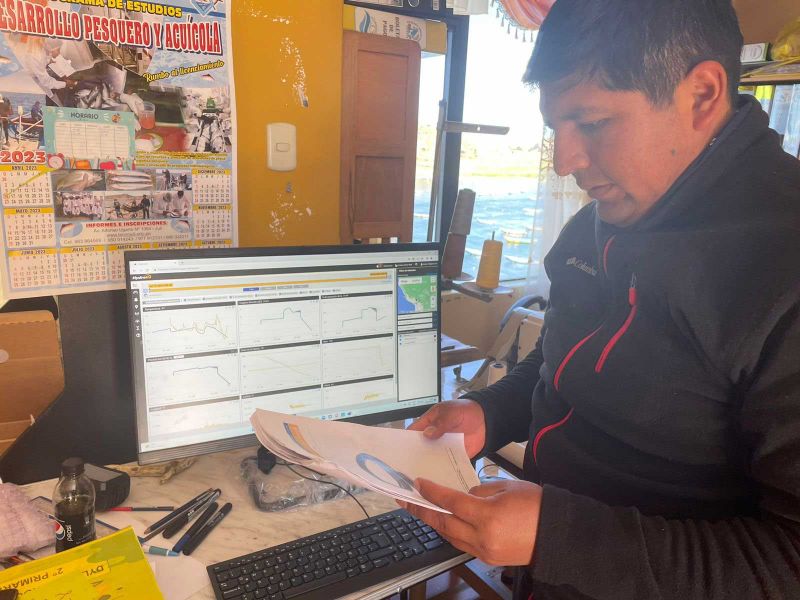Continuous DO Data Shifts Paradigm for Aquaculture Production
Published on by Marcus Miller, Digital Marketing Manager at In-Situ in Case Studies
Continuous DO Data Shifts Paradigm for Aquaculture Production
Overview
Titikaka Trout Peru is advancing aquaculture production in Lake Titicaca, Peru, through continuous monitoring of dissolved oxygen data, a strategy never before practiced in the region.
Challenge
At 3,812 meters (12,507 feet), Lake Titicaca is one of the highest-elevation lakes in the world. With a surface area of 8,372 square kilometers (3,232 square miles), 1,125 kilometers (699 miles) of coastline and forty-two islands, this large water body is a site of natural beauty, industry, and indigenous and colonial history and culture for local communities and tourists alike.
Lake Titicaca borders both Peru and Bolivia. On the Peruvian side, local governments created a plan to support the production of rainbow trout to feed the region’s growing population. So far, two hundred local aquaculture operations have set up small farms in the lake, producing about 32,000 tons of fish per year.
But mortality is high. Aquaculture is in an early stage in this remote location. Most farmers don’t have any way of monitoring dissolved oxygen at all and can lose more than fifty percent of their stock as a result.
Continuous dissolved oxygen data could make huge improvements in production, helping local businesses grow their profits and support their communities.
But environmental impacts could accompany an increase in production. Local governments want to monitor water quality in Lake Titicaca closely to ensure that aquaculture operations exist in harmony with this important landmark and the communities that call it home.
Solution
After learning of the potential to monitor dissolved oxygen continuously, Titikaka Trout Peru made the bold decision to incorporate new technology into their business, the first of the two hundred aquaculture producers in Lake Titicaca to install any kind of monitoring device.
Titikaka Trout Peru worked with William A. Villegas Calero, a distributor for Ceneris Environmental & Hygiene Solutions, based out of Arequipa, Peru, to install In-Situ’s Rugged Dissolved Oxygen (RDO®) Pro-X probe with VuLink telemetry in one of their open pens. Calero traveled 300 kilometers to Lake Titicaca and stayed for several days to help Titikaka Trout Peru with the setup and installation and answer their questions about the equipment.
“Just giving them the equipment is not a full solution,” says Calero. “It’s about making sure they’re comfortable with it. Providing continuous support post-purchase sets clients up for success by giving them the tools they need to use the equipment efficiently and strategically.”
Calero notes In-Situ provides more resources and assistance post-purchase compared to other manufacturers he distributes. “That’s the value of In-Situ,” he says.
Now, Titikaka Trout Peru can access continuous dissolved oxygen data in HydroVu, where they can graph, manage and observe their data in real time. With the aim of installing aerators to modulate dissolved oxygen levels, Titikaka Trout Peru will use the data from the RDO Pro-X to understand how dissolved oxygen levels fluctuate over the course of the day.
This marks the beginning of a new phase in Titikaka Trout Peru’s operation. Getting more information about water quality in the lake will help them assess the current situation and identify the right solution to lower the mortality rate for their stock.
If they choose to invest in aerators in the future, continuous DO data would allow them to respond in real time to fluctuations in oxygen levels, giving them greater control over their water quality, the survival rate of their fish and the density at which they’re able to farm.
Results
Actionable, real-time DO data makes a world of difference to the survival rate of fish and the profitability of a business.
Taxonomy
- Aquaculture
- Aquaculture Systems
- Environmental Health
- Environmental Compliance
- Environmental Policy
- Water Quality
- Environmental Consequences
- Fisheries
- Hydrodynamics & Water Quality
- Environmental Impact Assessment
- EU environmental policy
- Environmental Conservator
- Environmental Justice
- Water Quality Management
- Water Quality Training
- Water Quality Monitoring
- Aquafarming
- Fish Farming
- Fisheries governance
- Environmental Impact
- Environmental Engineering
- Environmental Consulting
- Environmental Services
- Environmental Report Writing
- Quality & Environmental Management
- Environmental Assessment & Management
- Geo-environmental engineering
- Environmental Health & Safety Management
- Environmental Services and Mitigation
- Environmental Science
- Environmental Engineering
- Environmental Impact Assessment
- Environmental Systems
- Environmental Impact
- Environmental Research
- Water Quality Monitoring
- Environmental
- Environmental Health Sanitarian
- Environmental Impact
- Environmental Impact
- Environmental Regulations
- Water quality
- Environmental Engineer
- Water Quality Research
- environmental management
- environmental management
- Environmental Regulation Management
- Environmental DNA (eDNA)
- Environmental Engineers & Consultants
- Environmental Impact Assessment (EIA) for Wastewater
- M.Tech Environmental Engineering and Management
- Environmental Health systems thinking
- Environmental Toxicologist
- Water quality technician
- Environmental Policies Regulation Management
- Water Quality Monitoring Sensor
- Environmental RNA (eRNA)
- Water Quality
- Environmental Managment
- Environmental And Social Assessment And Implementation And Disaster Risk Management
- Environmental Sampling
